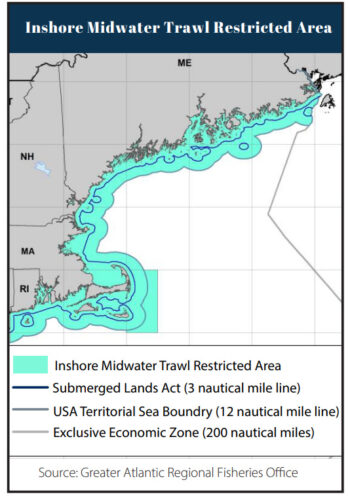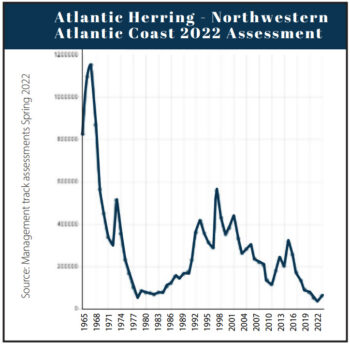This article is reprinted with permission from the latest edition of the Wild Oceans Horizon newsletter.
For the past year, Wild Oceans and a core group of partners built a coalition of more than thirty recreational fishing, watershed, and environmental organizations to bring about a new action to develop near-shore protections for Atlantic herring, river herring and shad. In September, the New England Fishery Management Council voted to initiate an action, Amendment 10 to the Atlantic Herring Fishery Management Plan, to develop and implement management actions designed to help attain optimum yield and improve the conservation status of Atlantic herring. The Council stated this will be achieved by accounting for its critically important role as a forage species in the ecosystem and minimizing user conflicts created by competing interests on the herring resource between the directed herring fishery and other user groups, including commercial and recreational fisheries, whale watching, and tourism.
The Council initiated Amendment 10 in response to a U.S. Federal District Court decision striking down the “Buffer Zone” implemented in Amendment 8 to the Plan. The court found a lack of documented evidence of localized depletion in the record for the decision, the stated rationale put forward by the New England Council and National Marine Fisheries Service. The Buffer Zone provided a spatial management component to Amendment 8’s efforts to improve ecosystem considerations in the Atlantic herring fishery through an ecosystem-based control rule. When it was in place from 2021 to 2022, the Buffer Zone prohibited midwater trawl gear from fishing within 12 miles of shore in the New England region, bumping out 20 miles around Cape Cod. Because of their size and tow-speed, mid-water trawlers, often working in pairs towing a small-mesh net between them, can capture millions of Atlantic herring, river herring, and shad in a single trip. Federal fisheries data collection programs are not designed to detect localized depletion; however, that does not mean that stakeholders who depend on a healthy forage base are not seriously impacted by the largest vessels on the East Coast operating close to shore. Hundreds of stakeholders – striped bass anglers, commercial groundfish and tuna fishermen, whale and bird watching tour operators – had testified that midwater trawls were affecting their businesses by rapidly depleting areas of forage or causing other conflicts.
In view of the court’s ruling, the Council has squarely rooted the purpose of Amendment 10 in the Magnuson-Stevens Act’s National Standards, in particular National Standard 1 which requires that fishery management measures prevent overfishing while achieving optimum yield on a continuing basis. The 2022 Atlantic Herring Stock Assessment shows that overfishing had been occurring for years, with herring currently deemed overfished and at historically low levels of abundance. The Atlantic herring plan defines optimum yield as the amount of fish that provides the greatest overall benefit to the Nation and requires maintenance of a biomass that supports the ocean ecosystem, predator consumption of herring, and a biologically sustainable human harvest. This includes recognition of the importance of Atlantic herring as one of many forage species of fish, marine mammals, and birds in the region. While the fishery control rule helps to ensure that the overall harvest accounts for region-wide ecosystem needs, spatial/temporal measures are needed to help ensure that optimum yield is achieved by accounting for where, when, and how that harvest takes place. This can protect spawning grounds, reduce bycatch, reduce user conflicts, and leave bait in the water for fish and fishermen alike, all helping to rebuild the resource and ensure that the benefits provided by the Atlantic herring resource are shared by all stakeholders.
The news got even better at the New England Council’s December meeting as development of new nearshore river herring and shad protections were added to Amendment 10. Wild Oceans has pointed out for years that existing river herring catch caps in the Atlantic herring fishery are inadequate because they are not based on river herring and shad biology and fail to effectively incentivize bycatch avoidance because of chronically poor catch monitoring. A 2021 Mid-Atlantic Council report identified four persistent river herring and shad bycatch hotspots using observer data for three time periods ranging from 2008 to 2019. This timeframe precedes implementation of the Amendment 8 Buffer Zone, thus indicating what bycatch could look like in its absence. When compared to the Buffer Zone map above, it indicates that river herring and shad populations were afforded protection by the Buffer Zone. This was confirmed in a recent paper discussed in our Spring edition of The Horizon, which found that nearly 6 million river herring were killed as bycatch over the study time-period and concluded that southern New England and mid-Atlantic alewife populations would have benefitted if the Amendment 8 Buffer Zone had remained in place. Recognizing the significant overlap between Amendment 10’s purpose to develop new nearshore spatial and temporal protections for Atlantic herring and the desire to address the times and locations where river herring and shad are most vulnerable to incidental catch, the Council expanded the scope to include consideration of time/area closures or revised catch caps.
Amendment 10 public scoping runs from March 1-April 30 (8am), and the Council is hosting six hearings (meeting schedule here) and asking for written comments to be submitted to comments@nefmc.org. If you would like more information, please check out the Council’s scoping document and/or visit here.
We are asking for your help in getting the word out about Amendment 10, so that NEFMC receives as much feedback as possible about the detrimental effects of the midwater trawl fleet on recreational access, river herring and shad runs, and critical nearshore habitats. In order to get involved, here’s what you can do:
- Attend/ask your members to attend an in-person scoping meeting (meeting schedule here: March 1-April 22).
- Write/ask your members to write comments and send to comments@nefmc.org (March 1-April 30 at 8am).
This will provide an opportunity for stakeholders affected by the fishery to bring forward examples of impacts of the directed Atlantic herring fishery on their businesses or recreational interests, including user conflicts with midwater trawlers or other herring fishing gear, options for new time/area closures along the coast, and other environmental or socioeconomic issues that should be analyzed by the Council as it moves forward with Amendment 10. Wild Oceans will continue to lead efforts to protect the critical forage base in New England.




